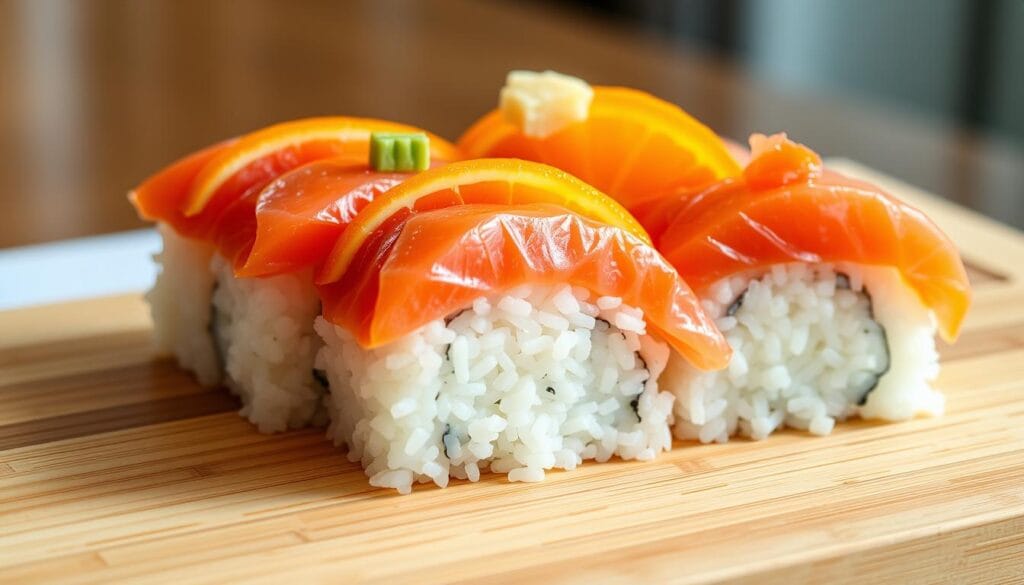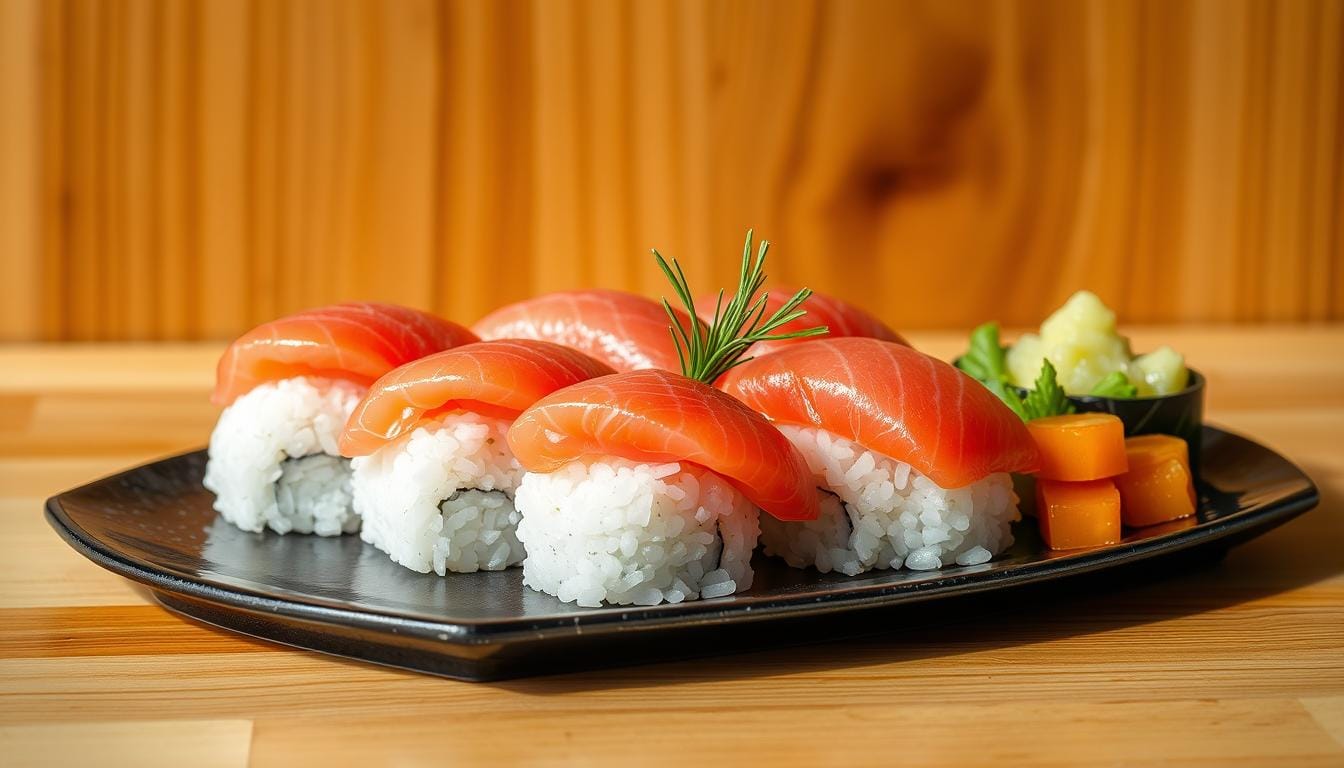Savory Salmon Sushi: Indulge Your Ultimate Sushi Cravings
Imagine biting into a piece of salmon sushi. The mix of fresh salmon, vinegared rice, and spices bursts with flavor. If you love sushi, you know how great salmon sushi is. It’s full of taste and good for you, making it a favorite everywhere.
Whether you want real salmon sushi or something fresh, this article will show you how. You’ll learn to make your own salmon sushi that tastes amazing.
From the basics to advanced techniques, you’ll get all the info you need. Sushi is getting more popular, so knowing how to make salmon sushi is key. You’ll learn about the different types of salmon and the cultural side of salmon sushi. Let’s explore the world of salmon sushi together.
Table of Contents
Understanding the Art
Exploring sushi, you’ll find salmon sushi is a favorite. Its rich taste and firm texture make it perfect for many dishes. Knowing its history and cultural value is key to enjoying salmon sushi.
Salmon sushi is a big hit in Japanese food, with many restaurants offering their take. You can find everything from classic nigiri to creative rolls. Surveys show 25% of sushi fans choose salmon.
There are many popular salmon sushi dishes. You might enjoy salmon nigiri, sashimi, or rolls. These dishes highlight salmon’s versatility and how well it pairs with ingredients like wasabi and soy sauce.
History of Salmon in Japanese Cuisine
Salmon has been in Japanese food for centuries, starting in the Edo period. Back then, it was a luxury food for special events. Now, it’s a common ingredient in Japanese dishes, including sushi.
Different Types
Several types of salmon are used in sushi, like Atlantic, Pacific, and sockeye. Each has its own taste and texture, fitting different sushi styles. For example, Atlantic salmon is great for sashimi, while Pacific salmon works well for grilled dishes.
The Cultural Significance
Salmon sushi is deeply rooted in Japanese culture. It’s about finding the right balance of flavors and textures. Making salmon sushi is an art that chefs master over years. Whether you’re new to sushi or a seasoned fan, salmon sushi’s cultural importance is undeniable.
Selecting The Premium
Choosing the right salmon is key for great salmon nigiri sushi. You need a premium that’s fresh and of high quality. With wild-caught and farmed salmon to choose from, picking the best can be tough.
Here are some tips to help you decide:
- Origin: Choose salmon from trusted fisheries or farms.
- Species: King, Sockeye, and Atlantic salmon have different tastes and textures.
- Freshness: Fresh salmon is pricier but tastes better.
Global Seafoods has a wide selection of salmon. They offer wild Sockeye, King, and farmed Atlantic salmon. Their salmon is full of omega-3s, which is good for your heart. You can grill, smoke, or use it for sushi.
For a main dish, aim for 6-8 ounces of salmon per person. For appetizers, 3-4 ounces is enough. Farmed Atlantic salmon is common and tastes mild. Wild-caught salmon, like King and Sockeye, have richer flavors.
| Salmon Type | Price Range | Flavor and Texture |
|---|---|---|
| King Salmon | $20-$50 per pound | Rich flavor and firm texture |
| Sockeye Salmon | $15-$30 per pound | Deep red color and robust flavor |
| Atlantic Salmon | $10-$25 per pound | Mild flavor and melt-in-your-mouth texture |
By thinking about these points, you can pick the best premium salmon sushi for your dish. Whether it’s fresh salmon sushi or salmon nigiri sushi, you’ll make a great choice.
Essential Tools and Ingredients
To make delicious salmon sushi, you need the right tools and ingredients. For raw salmon sushi, a sharp knife and cutting board are key. They help you handle the fish safely and hygienically. A sushi rolling mat is also crucial for best salmon sushi rolls. It helps you get the perfect shape and texture.
For authentic flavor, use Japanese short-grain rice, rice vinegar, and wasabi paste. You can also try different fillings like prawns, tuna, and veggies. This way, you can create unique salmon sushi variations.
Must-Have Sushi-Making Equipment
- Sushi rolling mat
- Sharp knife
- Cutting board
- Rice spreader or spatula
- Wooden spoon and bowl
Key Ingredients for Authentic Flavor
Japanese seasoned rice vinegar is essential for sushi rice. Soy sauce is good for dipping, but don’t overdo it. Adding wasabi paste to your salmon sushi gives it an extra kick.
Proper Rice Selection and Preparation
For perfect sushi rice, use Japanese short-grain rice. Season it with rice vinegar, salt, and sugar. Let it cool before rolling your best salmon sushi rolls. This makes assembly easier and enhances flavor.
How to Make Restaurant-Quality at Home
To make authentic salmon sushi, you need fresh salmon, short-grain white rice, and nori seaweed. These ingredients help you create delicious sushi at home. Making sushi involves several steps, like preparing rice, handling salmon, and assembling the rolls.
It’s crucial to use safe-to-eat raw salmon. Check its freshness by smell and texture. Start by rinsing and cooking the rice with the right water amount. Season it with rice vinegar, sugar, and salt for taste and texture.
To make sushi rolls, cut nori sheets and lay them flat. Spread sushi rice on the nori, leaving a border. Add fillings like salmon, carrots, and cucumbers. Roll the sushi with a bamboo mat and slice it.
When making sushi, remember to use short-grain rice and handle salmon gently. Assemble the rolls carefully. Follow these tips to make sushi that impresses everyone. Enjoy making salmon maki or nigiri with fresh salmon and quality ingredients.
Popular Variations
Salmon sushi comes in many forms, from classic to modern. You can try everything from salmon nigiri to creative rolls. The spicy salmon roll mixes salmon with sriracha for a kick. The Philadelphia roll adds cream cheese and cucumber for a unique taste.
Looking for something new? There are many modern salmon sushi options. Here are a few:
- Salmon sashimi, which is thinly sliced salmon served with soy sauce and wasabi
- Salmon temaki, which is a hand roll filled with salmon and other ingredients
- Salmon uramaki, which is a roll filled with salmon and other ingredients, wrapped in nori seaweed
Whether you prefer classic or adventurous, there’s a salmon sushi for you. Its rich flavor and health benefits make it a favorite in sushi places. So, why not try some of the popular salmon sushi dishes out there?
| Type | Description |
|---|---|
| Salmon Nigiri | Classic salmon sushi topped with wasabi and soy sauce |
| Spicy Salmon Roll | A roll filled with salmon, sriracha, and cucumber |
| Philadelphia Roll | A roll filled with salmon, cream cheese, and cucumber |
Safety Guidelines for Raw Salmon Preparation
When making raw salmon sushi, it’s key to follow safety rules to avoid foodborne illnesses. You must handle and store raw salmon correctly. This includes keeping it fresh and stored properly. Many people judge fish freshness by its appearance, like clear eyes and firm flesh.
Some folks prefer frozen fish over fresh because freezing kills harmful bacteria. But, make sure to thaw it slowly in the fridge overnight. Here are some tips for safe raw salmon sushi:
- Get fresh, sashimi-grade salmon from a trusted source.
- Keep raw salmon in a sealed container at 40°F (4°C) or lower.
- Be careful when handling raw salmon to avoid contamination.
It’s also vital to remember that some groups, like pregnant women and young kids, should not eat raw fish. When making raw salmon sushi, like sashimi, follow food safety rules closely. This way, you can enjoy your sushi while staying safe and healthy.

| Guideline | Importance |
|---|---|
| Source fresh, sashimi-grade salmon | High |
| Store raw salmon safely | High |
| Handle raw salmon safely | High |
Mastering
To make great salmon sushi, you must learn how to make sushi rice. Use short-grain sushi rice, which sticks together well when cooked. The right rice-to-water ratio is 1:1. Also, rinse the rice well before cooking to get rid of impurities.
After cooking, season the rice with rice vinegar, sugar, and salt. This mix gives your rice the right taste. Don’t stir the rice too much to avoid it becoming sticky. For authentic salmon sushi, the rice should be light and fluffy, enhancing the salmon’s flavor.
For premium salmon sushi, choose high-quality ingredients. Fresh, sustainable salmon and short-grain sushi rice are key. By following these tips and improving your sushi-making, you’ll impress everyone with your salmon sushi.
Here are some tips for making sushi rice for your salmon sushi creations:
- Use short-grain sushi rice for the best stickiness and texture.
- Rinse the rice thoroughly before cooking to remove any impurities.
- Avoid over-stirring the rice, as this can make it sticky and clumpy.
- Season the rice with a blend of rice vinegar, sugar, and salt for the perfect balance of flavors.
| Ingredient | Quantity |
|---|---|
| Sushi rice | 2 cups |
| Water | 2 cups |
| Rice vinegar | 1/3 cup |
| Sugar | 3 tablespoons |
| Salt | 1 teaspoon |
Pairing and Presentation Tips
Enjoying salmon sushi is better when you pair and present it right. You can make it taste great and look good by using traditional items, special plating, and choosing the right garnishes. For example, soy sauce, wasabi, and pickled ginger are great with traditional salmon sushi.
To make your salmon sushi even better, try these tips:
- Pair salmon sushi with avocado or cucumber to balance its richness.
- Use soy sauce, wasabi, and pickled ginger to add flavor.
- Try garnishes like sesame seeds or grated daikon for texture and looks.
Some favorite salmon sushi dishes include spicy salmon rolls, salmon nigiri, and salmon sashimi. You can enjoy them with drinks like sake or green tea. By using these tips, you can make your salmon sushi experience unique and fun.

| Dish | Pairing Options |
|---|---|
| Spicy Salmon Rolls | Soy sauce, wasabi, pickled ginger |
| Salmon Nigiri | Sake, green tea, avocado |
| Salmon Sashimi | Soy sauce, wasabi, sesame seeds |
Troubleshooting Common Problems
When making salmon sushi, you might run into a few issues. One big problem is the risk of food poisoning from raw salmon sushi. This can happen because of bacteria like Vibrio, Listeria, or Salmonella. To avoid this, make sure to handle and store your ingredients right. Freezing fish at -4°F or below can kill harmful parasites and bacteria.
Another issue is the freshness and quality of your best salmon sushi rolls. Freshness is key to safety. So, it’s important to buy fish from trusted sources and keep your workspace clean. Also, watch for signs of spoilage like a sour smell, sticky fish, or hard rice. If you see any of these, throw out the sushi to stay safe.
Some common problems and their solutions include:
- Improper storage: Store sushi in the fridge at under 40°F and eat it within 24 hours.
- Poor handling: Handle fish and other ingredients safely to prevent cross-contamination and bacterial growth.
- Low-quality ingredients: Choose fresh, high-quality fish and other ingredients to minimize the risk of food poisoning.
By following these tips, you can enjoy salmon sushi safely. Always focus on freshness, quality, and proper handling. This way, you’ll have a safe and tasty raw salmon sushi experience.
Conclusion:
Making salmon sushi at home is a rewarding journey. It requires patience, practice, and the right techniques. Authentic salmon sushi is a feast for the senses, showing the art and cultural value of Japanese cuisine.
Keep improving your sushi recipes and try different types of salmon. Use premium ingredients like sablefish. Enjoy the process of making each piece by hand and be proud of your delicious results. You’ll make sushi as good as your favorite sushi bars.
Keep learning and trying new things as you make sushi. Each dish you make will not only feed your body but also please your taste buds. It connects you to Japan’s rich culinary history. Let your love for sushi show in every bite you take.

